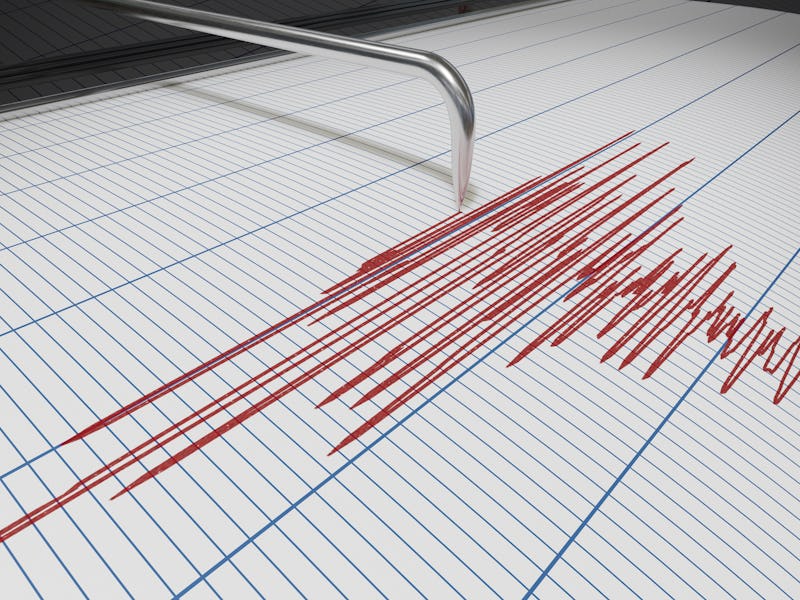What is an earthquake swarm? California's tremors explained
The chances of a big quake on the West coast are "significantly greater than usual."

Beginning Monday, parts of California were hit with an earthquake swarm that has scientists concerned that a larger-scale quake could be on its way.
Earthquake swarms are clusters of quakes occurring close to one another in both space and time. The earthquake swarm pinpointed to southern California began beneath the Salton Sea, located near Joshua Tree National Park. It's also located just south of the San Andreas fault — which stoked concerns over whether the swarm could trigger a larger-scale, more dangerous tremor.
As of Tuesday, the largest earthquake in the swarm has been a 4.6 magnitude. In the most likely scenario, subsequent quakes could reach a 5.4 magnitude, according to the US Geological Survey (USGS). The chances of that being the largest quake are about 80 percent.
The USGS expects the rate of earthquakes to drop in the next week or so. While the scenario of a 5.4 or lower quake is the most likely, the agency also estimates that, over the next seven days, there's a 19 percent chance of a 5.5 to 6.9 quake and a 1 percent chance of a quake with a magnitude of 7 or higher.
This time is different — On Monday at 4:30 pm PST, the USGS announced that the “probability of larger earthquakes in this region is significantly greater than usual."
This isn't the first time this area of the US has experienced an earthquake swarm: The most recent was in 2016. It was also located near the San Andreas fault, as were swarms that hit the area in 2001 and 2009.
"It's a really active area right there in the Sea. Lots of small earthquakes and they tend to be swarmy," Morgan Page, a research geophysicist with the U.S. Geological Survey, told LAist. "In the past, these swarms have gone on for about a week or so."
While earthquake swarms can cause some concern for those living near the area, these are naturally occurring events with some curious science behind them. Here's what you need to know.
What is an earthquake swarm?
They are clusters of earthquakes, which are typically on the smaller side, and tend to recur in the same areas — like the current swarm near the San Andreas fault. Most earthquake swarms are caused by geothermal activity.
How long do earthquake swarms last?
The average amount of time these events last is one week, USGS reports. But there's a range: They can be very short-lived, lasting for just a day, or persist for several weeks — even months.
What makes an earthquake swarm different from aftershock?
Aftershocks occur after a larger "mainshock" earthquake happens on a fault. The phenomenon is part of the land readjusting after the main earthquake. This can last for just a few days or weeks — or it can happen for years after a very large earthquake.
In contrast, earthquake swarms don't have a detectable main event that triggers them. They tend to be smaller all-around, and short-lived in comparison to aftershocks.
How do scientists predict an earthquake swarm?
Short answer: They can't.
"No one can predict the exact time or place of any earthquake, including aftershocks or events in swarms," the USGS said in a statement about the ongoing earthquake swarm in California.
Prediction is defined as including three elements: The date and time of a quake; its location, and its magnitude. Meeting those criteria is impossible, the USGS says.
However, USGS does use forecasts to broadly understand the likelihood of earthquakes and swarms happening in the future. They use data from past tremors to make predictions including how long the swarm will last.
Is the ongoing earthquake swarm building toward the 'Big One'? — The California earthquake swarm is concerning because of its proximity to a major fault line. The swarm "does increase the chance of a big earthquake on the San Andreas somewhat,” Morgan Page from USGS told the LA Times. “So it’s definitely something to watch.”
Given the unpredictability of earthquakes, this does not necessarily mean that something bigger is on its way. However, as Inverse reported the last time this area had an earthquake swarm, preparing for the Big One is better than not — so if you're in an area potentially affected by earthquakes, it would be well-advised to visit the USGS site for tips on how to prepare.